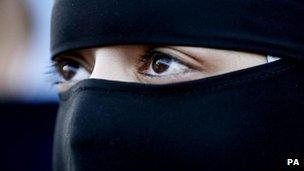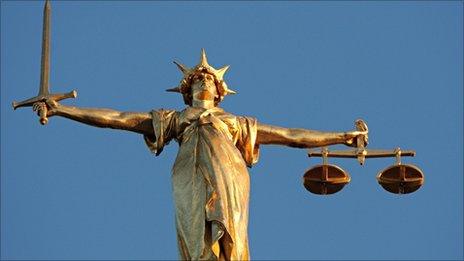Veil exposes courtroom quandary
- Published

Increasing numbers of British Muslim women are choosing to wear the face veil
Sitting in Blackfriars Crown Court in south London, I watched a very modern, multicultural dilemma.
Back in August, a Muslim woman was due to appear, accused of intimidating a witness. The woman, whom the BBC isn't naming for legal reasons, was expected to enter a plea.
But Judge Peter Murphy said he could not hear that plea because he could not identify her: she was wearing a niqab, the type of black face covering worn by some Muslim women that only leaves their eyes visible.
The woman's religious beliefs are that she should wear the veil in public so that men cannot look upon her face.
The vast majority of Islamic scholars say there is no obligation to veil and very few women in Britain wear it. But for some women it is clearly part of their beliefs.
So what was the court to do? When the case returned on Thursday, there was a compromise of sorts.
Liberal approach
A female police officer was in court who had witnessed the defendant being photographed in custody.
With the judge's agreement, the WPC went into a back room with the defendant and closed the door. There, the woman briefly removed her niqab.
The pair returned to court and the WPC entered the witness box and confirmed under oath that the defendant was, indeed, the defendant.
That testimony meant the hearing could continue. The defendant entered the dock, pleaded not guilty, and the process moved along.
But it was only a partial compromise because the judge must still rule on how the veil will be dealt with at the woman's eventual jury trial.
This is believed to be the first time a hearing has been stopped because a judge said a court could not satisfactorily identify a defendant because their face was covered for religious reasons.
So what's the legal position? There is no ban on the niqab in court - just like there is no ban on the face covering in other public spaces.
That's because British law has long taken a liberal approach to religious freedom, underpinned by the European Convention on Human Rights, external.
Article nine of the convention protects freedom of religion, including the right to manifest it in a particular way.
'Impact on dignity'
What that means in practice is that if religious dress is part of observance, it's no business of the state to tell you to change the way you appear.
Except... the convention also says the state can tell you to remove your religious dress if that's necessary to achieve some other public good - such as maintain security, law and order and the safety of others.
Susan Meek, defending the woman, said she had the right to wear the niqab in private and public because it was part of the way she expressed her cultural and religious beliefs.
She argued that the issue had to be dealt with on a case-by-case basis. The principle of open justice had not been damaged, she argued, because the jury and (in theory) the press could see a photograph of the woman taken while she had been in custody.
Underpinning those arguments is the Equal Treatment Bench Book, external, a manual for judges that aims to prevent discrimination in court.
The guide acknowledges that for some women the niqab can be "an important element of their religious and cultural identity".
It goes on: "To force a choice between that identity and the woman's involvement in the criminal, civil justice, or tribunal system... may well have a significant impact on her sense of dignity."
The manual tells judges to focus on whether it's appropriate in the circumstances to ask a woman to remove a niqab.
'Unsatisfactory'
"How does the ability or not to observe her facial expressions impact on the court's decision-making," it asks.
"The experience of many judges has shown that it is often possible to evaluate the evidence of a woman wearing a niqab, hence the need to give careful thought to whether the veil presents a true obstacle to achieving justice."
Kate Wilkinson, the prosecutor in the Blackfriars case, said judges had to think of real impediments to justice. The obvious hypothetical case would be one in which eyewitnesses must identify a defendant - the finger-pointing "it was her" moment. This wasn't that kind of case, she said.
But the judge said: "It cannot be satisfactory that one judge may go one way and another judge will go another way."
He asked whether the absence of a clear position created a "degree of privilege" which ultimately meant some defendants could dictate to the court how they would appear.
There have been similar cases in other countries. France has banned all face coverings in public spaces and there have been instances where veiled women have been told they cannot enter a court. That legal battle continues.
In Canada the case of a veiled witness went to Canada's Supreme Court. Its justices narrowly ruled in her favour - but also advised a case-by-case approach.
Judge Murphy will rule on Monday on how the case will proceed. If he rules against the woman, the case is likely to end up across the Thames in the higher courts.
- Published12 September 2013

- Published23 August 2013
